Prediction of Durability of Thermal Insulating Epoxy Coatings with Regard to Climatic Ageing
Abstract
:1. Introduction
- Improve thermal insulation properties;
- Reduce the weight of the coatings;
- Increase the heat and light reflectivity of the coatings.
- At work [18], the results showed that the functionalization and chemical compatibility of APTES-treated MWCNTs with an epoxy composition provides increases of the physical and mechanical properties of epoxy composites: bending stress increases by 194% and bending modulus increases by 137%; the tensile strength increases by 108% and the tensile elastic modulus increases by 52%; impact strength increases by 300%.
- At work [19] in this study, the mechanical properties of the composites were tested by changing particle size, volume fraction and temperature. The mechanical properties of the composites were improved by optimizing the fabrication conditions by controlling the viscosity of the composites.
2. Materials and Methods
2.1. Materials
- Epoxy resin ED-20 (epoxy-dian resin)—dynamic viscosity at (25 ± 0.1) °C—12–25 Pa·s, gelatinization time at least 4 h, mass fraction of epoxy groups at least 20–22.5%; Etal-247 is a low-viscosity modified epoxy resin. Viscosity 20–22 times lower than ED-20, gelatinization time at least 1.5 h, mass fraction of epoxy groups at least 21.4–22.8%;
- Hardener Etal-1440N is a low-viscosity two-pack epoxy compound, viable for up to 3 h, curing period 24 h, at 20–25 °C, workable up to 110 °C after additional heat treatment; Etal-1460 amine type is a homogenous low-viscous liquid of light to dark brown color, designed for the curing of epoxy resins and compounds based on them at 0–+40 °C in any humidity and under water, curing time of compound at 0–10 °C is 24 h, at 10–20 °C is 16 h; Etal-45M is an amine type hardener used to harden epoxy resins and compounds based on them at temperatures from −7 °C (recommended from +5) to +45 °C, % humidity is not important; polyethylene polyamine (PEPA) is a cold-curing hardener for epoxy resins and compositions. It is a mixture of ethylene amines. PEPA is fully soluble in water and in alcohol. Plasticizer-dibutyl phthalate (DBPT), coal tar—(CT); diluents-butanol; fillers-microsilica (McS) and microspheres (MS); antioxidants (AO)-salicylic and phenolic acids.
2.2. Methods
- –
- Thermal conductivity measurement range—0.02–1.5 W/(m·K);
- –
- Thermal resistance measurement range—0.01–1.5 m2·K/W;
- –
- The limits of permissible relative error in measuring thermal conductivity and thermal resistance are ±5%;
- –
- Thickness of the measured sample—10–25 mm.
- 1)
- Dosing of epoxy resin, hardener, and microspheres and thinner, using a laboratory scale;
- 2)
- Mix the components in a laboratory mixer. Mixing is done at 60–70 rpm for 10–15 min.
- 3)
- The resulting composition is passed through a strainer and fed to the filler. To obtain a high-quality coating, it is necessary to ensure a high level of physical and mechanical properties (hiding power, density and layer thickness). It is therefore recommended that for primed surfaces the material consumption should not exceed 400 g/m2 for the first coat. For rough surfaces the consumption rate for the first coat is increased by 20–30%.
3. Results
3.1. Test Results
3.2. The Experimental Research Results
4. Discussion
- Coatings based on formulations cured with Etal-45M are characterized by the greatest color variation during 10 months of exposure to the natural climate.
- The proposed mathematical model makes it possible to reliably describe the process of change in the decorative properties of epoxy coatings depending on the duration of field exposure, total solar radiation and ultraviolet A and B radiations.
- The most decorative resistant coatings are obtained using epoxy resin ED-20 + modified epoxy resin Etal-1440N. The recommended coating composition for the epoxy coating groups is shown in Table 6.
- The use of the personal computer “Statistical analysis of color components of paintwork coatings” does not require expensive equipment (scans can be obtained by means of a common flatbed scanner), which makes its application the most expedient for the evaluation of the colorimetric characteristics of epoxy polymers and the paintwork coatings based on them. Given the critical values not perceived by the human eye (∆Eab∗ ≤ 2.75), a similar parameter ∆ECMYKH must not exceed 0.18 when using the direct-scanning method.
- In the process of research, it was found that under the influence of ultraviolet radiation, a process of micro-damage accumulation develops in the polymer coating, which adequately affects the color and durability of the coating.
- A mathematical model, Equation (6), describing the degradation process of polymer coatings based on experimental data of color difference change was developed.
5. Conclusions
Author Contributions
Funding
Institutional Review Board Statement
Informed Consent Statement
Data Availability Statement
Acknowledgments
Conflicts of Interest
References
- Dehbi, A.; Mourad, A.-H.I.; Bouaza, A. Degradation assessment of LDPE multilayer films used as a greenhouse cover: Natural and artificial aging impacts. J. Appl. Polym. Sci. 2011, 124, 2702–2716. [Google Scholar] [CrossRef]
- Marouani, S.; Curtil, L.; Hamelin, P. Ageing of carbon/epoxy and carbon/vinylester composites used in the reinforcement and/or the repair of civil engineering structures. Compos. Part B Eng. 2012, 43, 2020–2030. [Google Scholar] [CrossRef]
- Nizina, T.A. Protective and Decorative Coatings Based on Epoxy and Acrylic Binders; Publishing House of Ogarev Mordovia State University: Saransk, Russia, 2007; p. 260. [Google Scholar]
- Selyaev, V.P.; Bazhenov, Y.M.; Sokolova, Y.A.; Tsyganov, V.V.; Nizina, T.A. Polymer Coatings for Concrete and Reinforced Concrete Structures; SVMO: Saransk, Russia, 2010; p. 224. [Google Scholar]
- Potapov, Y.B.; Solomatov, V.I.; Selyaev, V.P. Polymer Coatings for Reinforced Concrete Structures; Stroyizdat: Moscow, Russia, 1973; p. 129. [Google Scholar]
- Fihri, A.; Abdullatif, D.; Saad, H.B.; Al-Baidary, H.; Bouhrara, M. Decorated fibrous silica epoxy coating exhibiting anti-corrosion properties. Prog. Org. Coat. 2019, 127, 110–116. [Google Scholar] [CrossRef]
- Krzywiński, K.; Sadowski, Ł.; Stefaniuk, D.; Obrosov, A.; Weiß, S. Engineering and Manufacturing Technology of Green Epoxy Resin Coatings Modified with Recycled Fine Aggregates. Int. J. Precis. Eng. Manuf.-Green Technol. 2022, 9, 253–271. [Google Scholar] [CrossRef]
- Frigione, M.; Lettieri, M.; Lionetto, F.; Mascia, L. Experimental cold-cured nanostructured epoxy-based hybrid formulations: Properties and durability performance. Polymers 2020, 12, 476. [Google Scholar] [CrossRef] [PubMed] [Green Version]
- Bell, A.M.; Keltsch, N.; Schweyen, P.; Ternes, T.; Buchinger, S. UV aged epoxy coatings—Ecotoxicological effects and released compounds. Water Res. X 2021, 12, 100105. [Google Scholar] [CrossRef] [PubMed]
- GOST R 52490-2005 (ISO 7724-3:1984); Paint and Varnish Materials. Colorimetry. Part 3. British Standards Institution: London, UK, 1984.
- Wang, X.; Tang, F.; Qi, X.; Lin, Z. Mechanical, electrochemical, and durability behavior of graphene nano-platelet loaded epoxy-resin composite coatings. Compos. Part B Eng. 2019, 176, 107103. [Google Scholar] [CrossRef]
- Maljaee, H.; Ghiassi, B.; Lourenço, P.B. Effect of synergistic environmental conditions on thermal properties of a cold curing epoxy resin. Compos. Part B Eng. 2017, 113, 152–163. [Google Scholar] [CrossRef]
- GOSTR 52489-2005 (ISO 7724-1:1984); Paints and Coating Materials. Colorimetry. Part 1. General Provisions. Standardinform: Moscow, Russia, 2006; p. 12.
- Kablov, E.N. System analysis of climate impact on mechanical properties of polymeric materials according to domestic and foreign sources (review). Aviat. Mater. Technol. 2018, 2, 47–58. [Google Scholar]
- Selyaev, V.P.; Startsev, V.O.; Nizina, T.A.; Startsev, O.V.; Nizin, D.R.; Molokov, M.V. Analysis of plasticizing effect of moisture on climatic resistance of epoxy polymers modified with aliphatic diluent Etal-1. In Bulletin of Privolzhsky Territorial Branch of RAASN; NNGASU: Nizhny Novgorod, Russia, 2018; pp. 200–205. [Google Scholar]
- Nizina, T.A.; Selyaev, V.P.; Nizin, D.R.; Chernov, A.N.; Artamonov, D.A. Modelling of Climatic Factors Influence on Strength and Decorative Characteristics of Modified Epoxy Composites. Corrosion, Aging and Biostability of Materials in Sea Climate. In Proceedings of the Collection of Reports of II International Scientific and Technical Conference, FSUE VIAM, Moscow, Russia, 23 September 2016; All-Russian Scientific Research, Institute of Aviation Materials. Available online: http://conf.viam.ru/conf/195/proceedings (accessed on 18 May 2016).
- Nizina, T.A. Influence of color of epoxy composites on the change of colorimetric characteristics in the process of full-scale exposure. Mon. J. Constr. Architect. 2016, 7, 67–80. [Google Scholar]
- Mostovoy, A.; Yakovlev, A.; Tseluikin, V.; Lopukhova, M. Epoxy Nanocomposites Reinforced with Functionalized Carbon Nanotubes. Polymers 2020, 12, 1816. [Google Scholar] [CrossRef] [PubMed]
- Sim, J.; Kang, Y.; Kim, B.J.; Park, Y.H.; Lee, Y.C. Preparation of Fly Ash/Epoxy Composites and Its Effects on Mechanical Properties. Polymers 2020, 12, 79. [Google Scholar] [CrossRef] [PubMed] [Green Version]
- GOST (Government Standard) 10587-84; Epoxy-Dian Uncured Resins. Technical Conditions. Publishing House of Standards: Moscow, Russia, 1989; 20p.
- Calculation of Color Differences; Date of Introduction 1 January 2007. Standartinform: Moscow, Russia, 2006; p. 14.
- GOST (Government Standard) R 57862-2017; Composites. Determination of Dynamic Modulus of Elasticity, Shear Modulus and Poisson’s Ratio by Acoustic Resonance. Standardinform: Moscow, Russia, 2019; 13p.
- Selyaev, V.P.; Selyaev, P.V. Physical-Chemical Bases of Fracture Mechanics of Cement Composites: Monograph; Publishing House of N.P. Ogarev Moscow State University: Saransk, Russia, 2018; p. 220. [Google Scholar]
- GOST 32299-2013 (ISO 4624: 2002); Paint and Varnish Materials. Determination of Adhesion by Tear-Off Method. Standartinform: Moscow, Russia, 2014; 15p.
- GOST (Government Standard) 7076-99; Materials and Articles of Construction. Method for Determination of Thermal Conductivity and Thermal Resistance under Steady-State Thermal Conditions. Standartinform: Moscow, Russia, 2000; 27p.

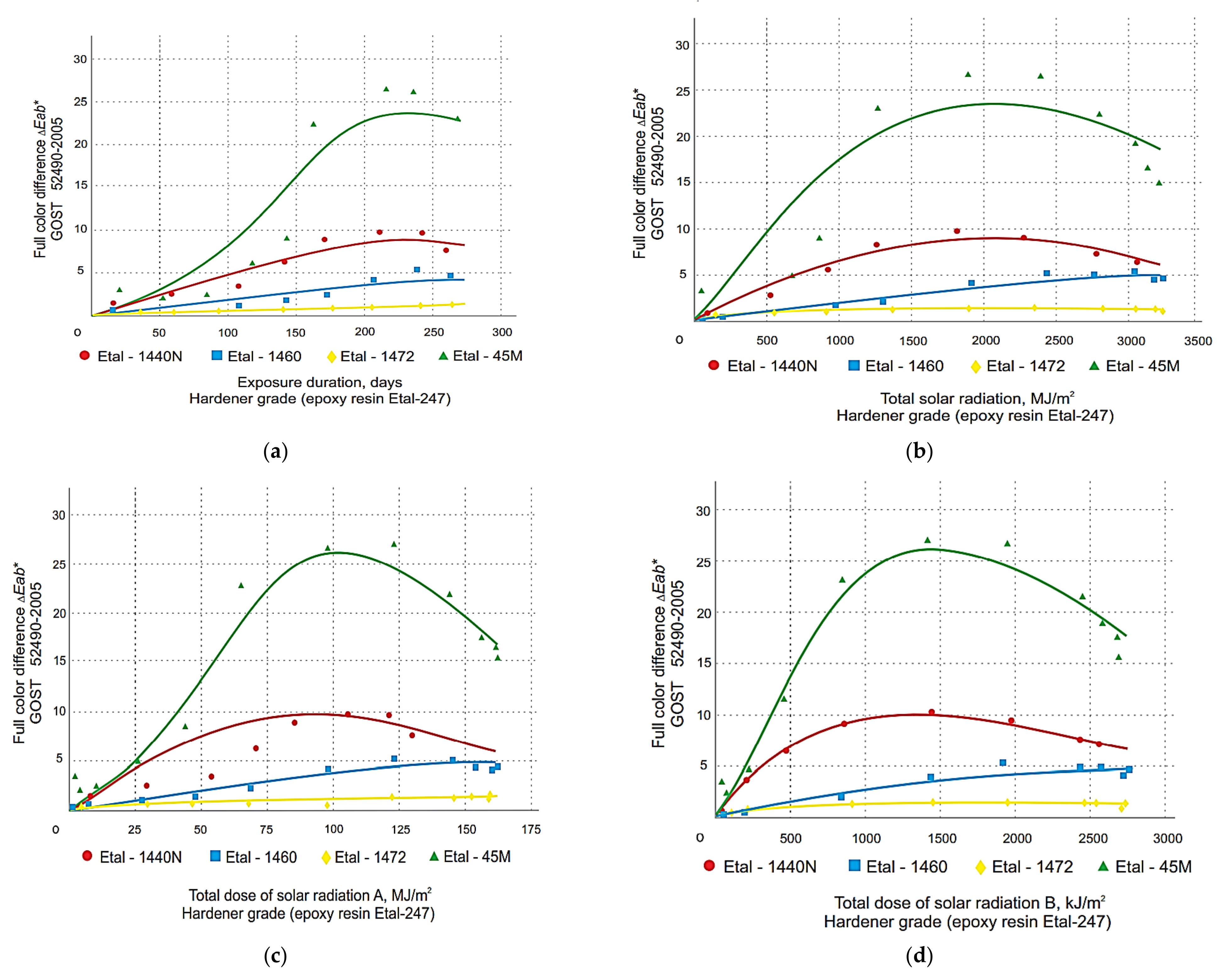
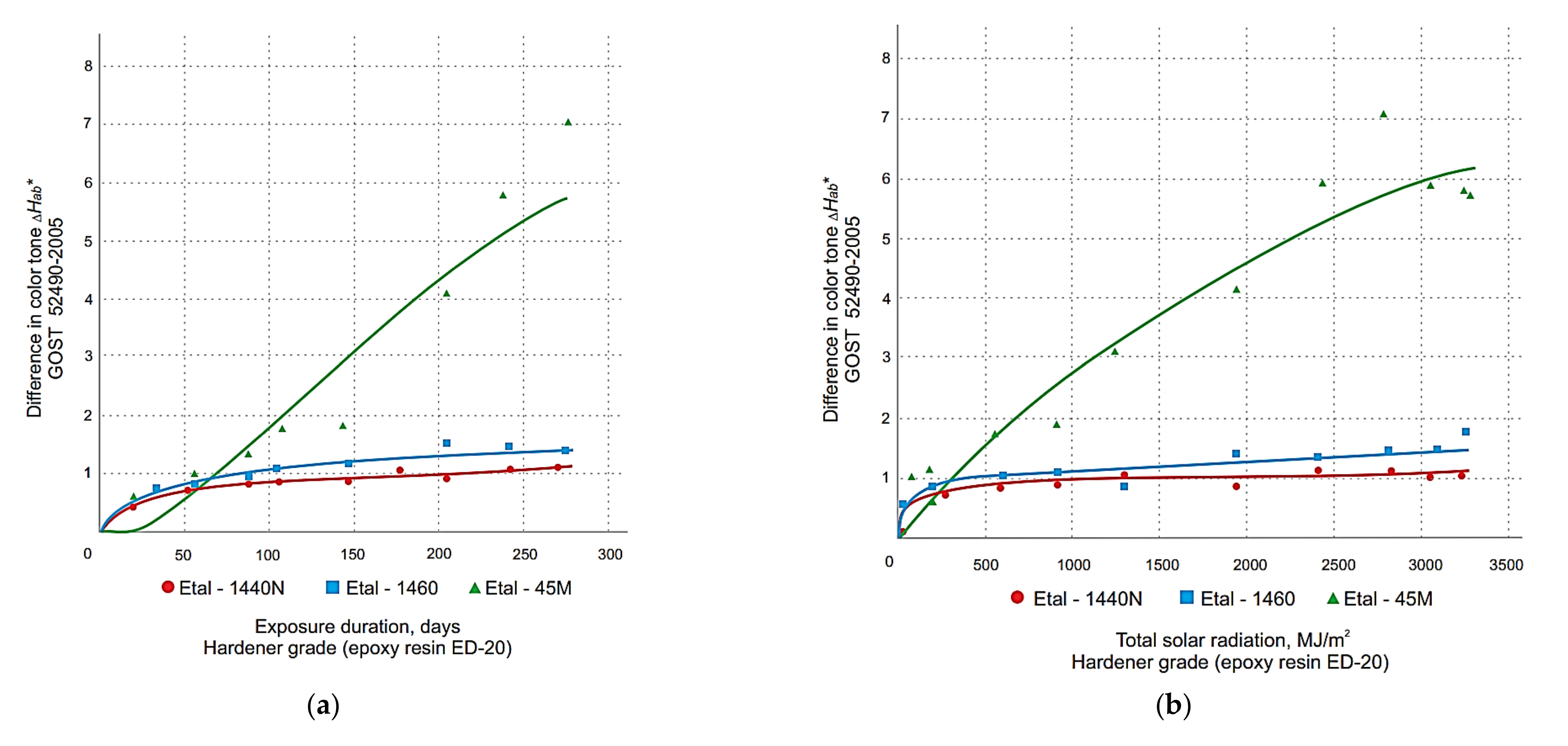
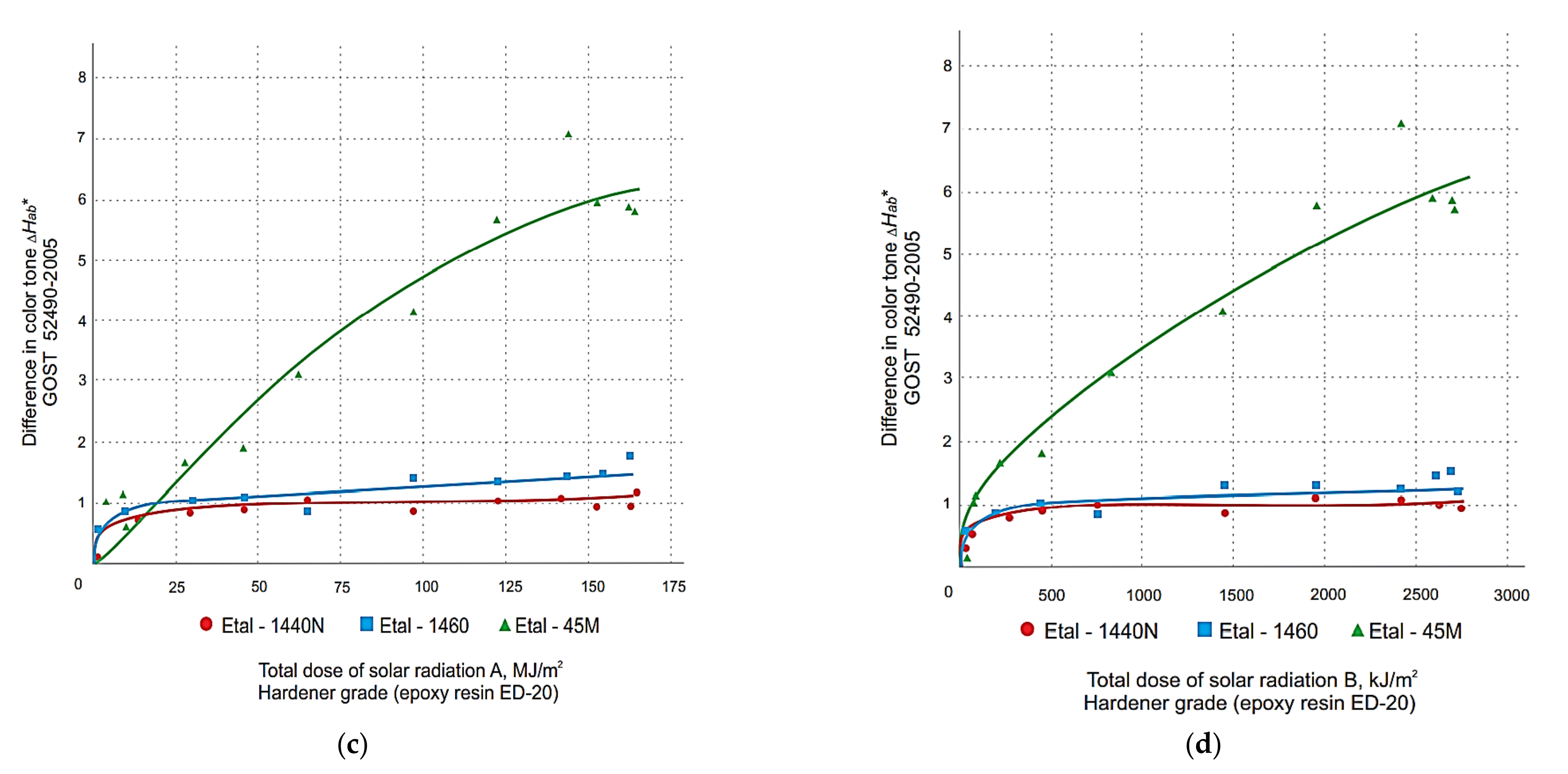
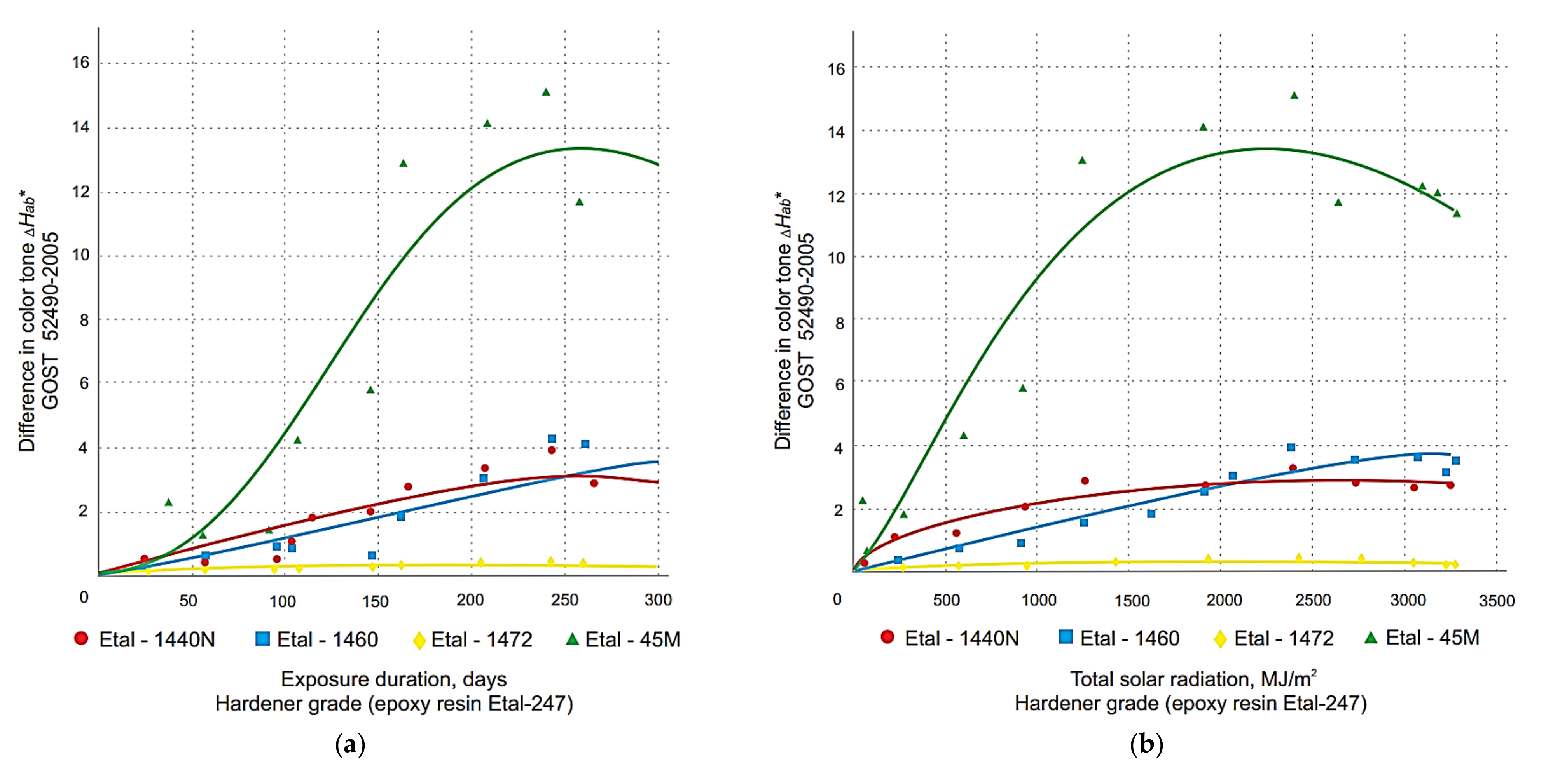

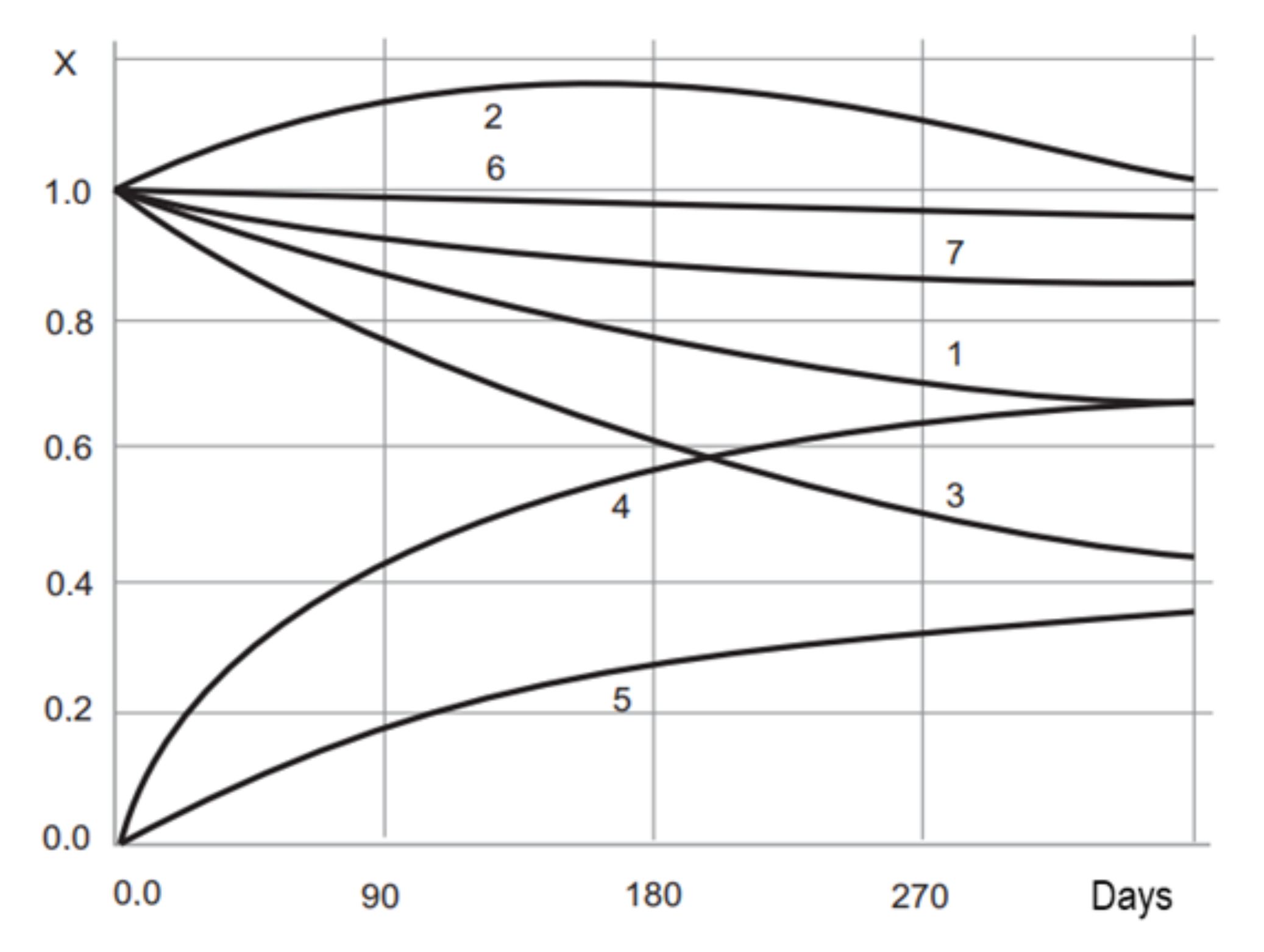
| No. | Epoxy Resin ED-20 | Polyethylene Polyamine (PEPA) | Dibutyl Phthalate (DBPT) | Microsilica/Microspheres | Antioxidants (AO) | Butanol | σ, MPa | E, MPa |
|---|---|---|---|---|---|---|---|---|
| 1 | 100 | 10 | - | - | - | - | 21 | |
| 2 | 100 | 10 | 10 | - | - | - | 20 | |
| 3 | 100 | 10 | 10 | - | - | 29 | ||
| 4 | 100 | 10 | - | - | - | 10 | 22 | |
| 5 | 100 | 10 | 10 | 2 | 10 | 28 | ||
| 6 | 100 | 10 | 10 | 2 | 10 | 25 |
| No. | Epoxy Resin Grade | Hardener Grade | Antioxidants (AO) | Diluent |
|---|---|---|---|---|
| 1 | Epoxy resin ED–20 | Polyethylene polyamine (PEPA) | - | - |
| 2 | Epoxy resin ED–20 | Modified epoxy resin Etal–1440N | - | - |
| 3 | Modified epoxy resin Etal–247 | Polyethylene polyamine (PEPA) | - | - |
| 4 | Epoxy resin ED-20 | Polyethylene polyamine (PEPA) | Phenolic acid | Butanol |
| Compound Number | Hardener Type | Considered Factor | The Values of the Coefficients of Equation (2) | |||
|---|---|---|---|---|---|---|
| αx | βx | γx | R2 | |||
| Epoxy Resin ED-20 | ||||||
| 1 | Modified epoxy resin Etal–1440N | T, days | 8.22 × 10−1 | 1.99 × 10−1 | 37,954 | 0.947 |
| Q, MJ/m2 | 1.16 | 9.80 × 10−2 | 31,989 | 0.932 | ||
| UA, MJ/m2 | 1.56 | 9.60 × 10−2 | 7914 | 0.932 | ||
| UB, kJ/m2 | 1.82 | 3.90 × 10−2 | 56,088 | 0.904 | ||
| 2 | Modified epoxy resin Etal–1460 | T, days | 3.20 × 10−1 | 6.03 × 10−1 | 312.8 | 0.860 |
| Q, MJ/m2 | 1.52 | 1.66 × 10−1 | 110,990 | 0.865 | ||
| UA, MJ/m2 | 1.20 | 4.02 × 10−1 | 127 | 0.724 | ||
| UB, kJ/m2 | 2.97 | 8.10 × 10−2 | 35,699 | 0.878 | ||
| 3 | Modified epoxy resin Etal–45M | T, days | 1.42 × 10−3 | 1.80 | 401 | 0.974 |
| Q, MJ/m2 | 4.61 × 10−2 | 7.19 × 10−1 | 7072 | 0.978 | ||
| UA, MJ/m2 | 3.70 × 10−2 | 1.37 | 172 | 0.940 | ||
| UB, kJ/m2 | 6.86 × 10−2 | 7.10 × 10−1 | 3547 | 0.946 | ||
| Epoxy Resin Etal–247 | ||||||
| 4 | Modified epoxy resin Etal–1440N | T, days | 6.00 × 10−4 | 2.12 | 242 | 0.844 |
| Q, MJ/m2 | 5.00 × 10−4 | 1.52 | 1758 | 0.955 | ||
| UA, MJ/m2 | 2.50 × 10−3 | 2.37 | 89.3 | 0.973 | ||
| UB, kJ/m2 | 3.60 × 10−3 | 1.29 | 1240 | 0.972 | ||
| Compound Number | Hardener Type | Considered Factor | The Values of the Coefficients of Equation (2) | |||
|---|---|---|---|---|---|---|
| αx | βx | γx | R2 | |||
| Epoxy Resin ED-20 | ||||||
| 1 | Modified epoxy resin Etal–1440N | T, days | 1.92 × 10−1 | 3.14 × 10−1 | 38,292 | 0.802 |
| Q, MJ/m2 | 3.03 × 10−1 | 1.67 × 10−1 | 65,902 | 0.807 | ||
| UA, MJ/m2 | 4.98 × 10−1 | 1.66 × 10−1 | 11,801 | 0.809 | ||
| UB, kJ/m2 | 5.88 × 10−1 | 8.3 × 10−2 | 40,498 | 0.824 | ||
| 2 | Modified epoxy resin Etal–1460 | T, days | 1.32 × 10−1 | 4.4 × 10−1 | 1240 | 0.851 |
| Q, MJ/m2 | 2.88 × 10−1 | 2.07 × 10−1 | 35,998 | 0.853 | ||
| UA, MJ/m2 | 5.37 × 10−1 | 2.03 × 10−1 | 7948 | 0.853 | ||
| UB, kJ/m2 | 6.70 × 10−1 | 9.8 × 10−2 | 38,798 | 0.787 | ||
| 3 | Modified epoxy resin Etal–45M | T, days | 4.00 × 10−5 | 2.44 | 363 | 0.924 |
| Q, MJ/m2 | 1.46 × 10−3 | 1.12 | 4858 | 0.937 | ||
| UA, MJ/m2 | 1.79 × 10−2 | 1.35 | 206.1 | 0.937 | ||
| UB, kJ/m2 | 6.86 × 10−2 | 5.81 × 10−1 | 16,810 | 0.941 | ||
| Epoxy Resin Etal-247 | ||||||
| 4 | Modified epoxy resin Etal–1440N | T, days | 8.00 × 10−4 | 1.77 | 292 | 0.913 |
| Q, MJ/m2 | 1.84 × 10−2 | 7.48 × 10−1 | 2608 | 0.929 | ||
| UA, MJ/m2 | 4.47 × 10−2 | 1.15 | 111.5 | 0.919 | ||
| UB, kJ/m2 | 4.00 × 10−2 | 6.87 × 10−1 | 1636 | 0.904 | ||
| Compound Number | Hardener Type | Considered Factor | The Values of the Coefficients of Equation (2) | |||
|---|---|---|---|---|---|---|
| αx | βx | γx | R2 | |||
| Epoxy Resin ED-20 | ||||||
| 1 | Modified epoxy resin Etal–1440N | T, days | 6.49 × 10−3 | 5.58 × 10−1 | 513 | 0.375 |
| Q, MJ/m2 | 1.74 × 10−2 | 2.45 × 10−1 | 8282 | 0.773 | ||
| UA, MJ/m2 | 3.63 × 10−2 | 2.41 × 10−1 | 481 | 0.773 | ||
| UB, kJ/m2 | 4.29 × 10−2 | 1.27 × 10−1 | 13,719 | 0.810 | ||
| 2 | Modified epoxy resin Etal–1460 | T, days | 2.15 × 10−2 | 3.94 × 10−1 | 1591 | 0.768 |
| Q, MJ/m2 | 4.08 × 10−2 | 1.97 × 10−1 | 150,189 | 0.744 | ||
| UA, MJ/m2 | 6.93 × 10−2 | 2.08 × 10−1 | 9596 | 0.743 | ||
| UB, kJ/m2 | 7.43 × 10−2 | 1.26 × 10−1 | 150,458 | 0.740 | ||
| 3 | Modified epoxy resin Etal–45M | T, days | 9.93 × 10−3 | 5.94 × 10−1 | 298 | 0.744 |
| Q, MJ/m2 | 3.65 × 10−2 | 2.04 × 10−1 | 2471 | 0.700 | ||
| UA, MJ/m2 | 5.56 × 10−2 | 2.79 × 10−1 | 116 | 0.712 | ||
| UB, kJ/m2 | 8.55 × 10−2 | 9.20 × 10−2 | 1575 | 0.716 | ||
| Epoxy resin Etal-247 | ||||||
| 4 | Modified epoxy resin Etal–1440N | T, days | 4.00 × 10−4 | 1.34 | 352 | 0.946 |
| Q, MJ/m2 | 3.00 × 10−4 | 0.1 | 2130 | 0.962 | ||
| UA, MJ/m2 | 4.70 × 10−3 | 1.10 | 109 | 0.954 | ||
| UB, kJ/m2 | 2.20 × 10−4 | 1.16 | 1360 | 0.871 | ||
| No. | Compositions |
|---|---|
| 1 | Epoxy resin ED-20 + modified epoxy resin Etal-1440N ratio (100:56) |
| 2 | Microspheres-20% |
| 3 | Thinner-from application technology |
| Compound Number | Epoxy Resin ED-20 | Polyethylene Polyamine (PEPA) | Dibutyl Phthalate (DBPT) | Microsilica/Microspheres | Antioxidants (AO) | Butanol | σ, MPa | E, MPa |
|---|---|---|---|---|---|---|---|---|
| 5 | 100 | 10 | 10 | 2 | 10 | 28 | ||
| 6 | 100 | 10 | 10 | 2 | 10 | 25 |
Publisher’s Note: MDPI stays neutral with regard to jurisdictional claims in published maps and institutional affiliations. |
© 2022 by the authors. Licensee MDPI, Basel, Switzerland. This article is an open access article distributed under the terms and conditions of the Creative Commons Attribution (CC BY) license (https://creativecommons.org/licenses/by/4.0/).
Share and Cite
Zhumadilova, Z.O.; Selyaev, V.P.; Nurlybayev, R.E.; Orynbekov, Y.S.; Sangulova, I.B.; Kuldeyev, E.I. Prediction of Durability of Thermal Insulating Epoxy Coatings with Regard to Climatic Ageing. Polymers 2022, 14, 1650. https://doi.org/10.3390/polym14091650
Zhumadilova ZO, Selyaev VP, Nurlybayev RE, Orynbekov YS, Sangulova IB, Kuldeyev EI. Prediction of Durability of Thermal Insulating Epoxy Coatings with Regard to Climatic Ageing. Polymers. 2022; 14(9):1650. https://doi.org/10.3390/polym14091650
Chicago/Turabian StyleZhumadilova, Zhanar O., Vladimir P. Selyaev, Ruslan E. Nurlybayev, Yelzhan S. Orynbekov, Indira B. Sangulova, and Erzhan I. Kuldeyev. 2022. "Prediction of Durability of Thermal Insulating Epoxy Coatings with Regard to Climatic Ageing" Polymers 14, no. 9: 1650. https://doi.org/10.3390/polym14091650
APA StyleZhumadilova, Z. O., Selyaev, V. P., Nurlybayev, R. E., Orynbekov, Y. S., Sangulova, I. B., & Kuldeyev, E. I. (2022). Prediction of Durability of Thermal Insulating Epoxy Coatings with Regard to Climatic Ageing. Polymers, 14(9), 1650. https://doi.org/10.3390/polym14091650







